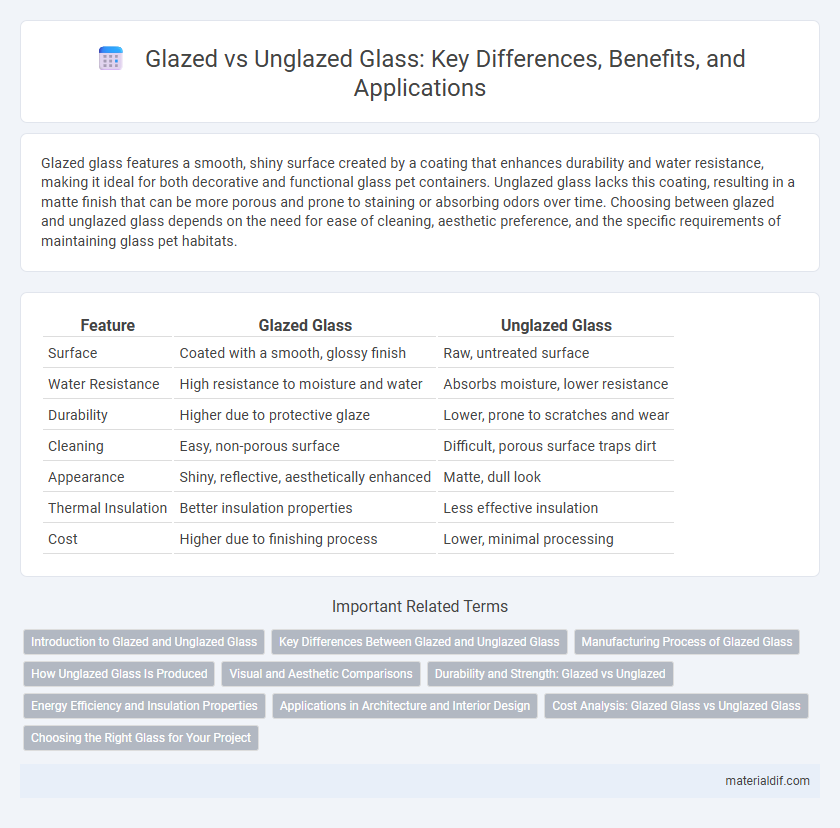Glazed glass features a smooth, shiny surface created by a coating that enhances durability and water resistance, making it ideal for both decorative and functional glass pet containers. Unglazed glass lacks this coating, resulting in a matte finish that can be more porous and prone to staining or absorbing odors over time. Choosing between glazed and unglazed glass depends on the need for ease of cleaning, aesthetic preference, and the specific requirements of maintaining glass pet habitats.
Table of Comparison
| Feature | Glazed Glass | Unglazed Glass |
|---|---|---|
| Surface | Coated with a smooth, glossy finish | Raw, untreated surface |
| Water Resistance | High resistance to moisture and water | Absorbs moisture, lower resistance |
| Durability | Higher due to protective glaze | Lower, prone to scratches and wear |
| Cleaning | Easy, non-porous surface | Difficult, porous surface traps dirt |
| Appearance | Shiny, reflective, aesthetically enhanced | Matte, dull look |
| Thermal Insulation | Better insulation properties | Less effective insulation |
| Cost | Higher due to finishing process | Lower, minimal processing |
Introduction to Glazed and Unglazed Glass
Glazed glass features a smooth, often reflective surface created by fusing a layer of glass to a substrate, enhancing durability, weather resistance, and aesthetic appeal. Unglazed glass lacks this coating, resulting in a raw, porous texture more prone to damage and less effective at insulating or repelling moisture. The choice between glazed and unglazed glass impacts factors such as maintenance requirements, thermal efficiency, and suitability for specific architectural or industrial applications.
Key Differences Between Glazed and Unglazed Glass
Glazed glass features a smooth, transparent coating that enhances durability, weather resistance, and aesthetic appeal, making it ideal for windows and decorative applications. Unglazed glass lacks this coating, resulting in a more porous surface that is prone to scratches, stains, and reduced thermal insulation. The key differences include surface finish, resistance to environmental factors, and maintenance requirements, which significantly influence their usage in construction and design.
Manufacturing Process of Glazed Glass
Glazed glass is produced through a specialized manufacturing process that involves applying a coating of molten glass or ceramic frit to the surface, which is then heated until vitrification occurs, creating a smooth, glossy finish. This process enhances the glass's durability, weather resistance, and aesthetic appeal by providing a sealed, non-porous surface. In contrast, unglazed glass lacks this coating, resulting in a more porous texture and reduced resistance to environmental factors.
How Unglazed Glass Is Produced
Unglazed glass is produced by omitting the final polishing or glazing step, which normally adds a smooth, reflective layer to the glass surface. This results in a matte finish that retains a slightly rough texture compared to glazed glass. The production process involves controlled cooling and surface treatments that prevent the formation of the glossy coating typical of glazed glass.
Visual and Aesthetic Comparisons
Glazed glass features a smooth, glossy surface that enhances light reflection and provides a polished, vibrant appearance, making it ideal for modern architectural designs and decorative applications. Unglazed glass exhibits a matte, textured finish that diffuses light softly, creating a subtle and understated aesthetic often used in rustic or industrial interiors. The choice between glazed and unglazed glass significantly impacts visual clarity, color vibrancy, and overall ambiance in both residential and commercial settings.
Durability and Strength: Glazed vs Unglazed
Glazed glass features a protective coating that enhances its durability by resisting scratches, stains, and weathering, making it stronger than unglazed glass. Unglazed glass lacks this protective layer, rendering it more susceptible to damage, chipping, and moisture penetration. The glazing process significantly improves the structural integrity and lifespan of glass products in both residential and commercial applications.
Energy Efficiency and Insulation Properties
Glazed glass features multiple layers or coatings that enhance its energy efficiency by reducing heat transfer and improving insulation, which helps maintain indoor temperatures and lower energy consumption. Unglazed glass lacks these protective coatings, resulting in higher heat loss and less effective insulation, making it less suitable for energy-conscious buildings. Advanced glazing technologies, such as low-emissivity (Low-E) coatings and argon gas fills, significantly improve thermal performance compared to standard unglazed glass panels.
Applications in Architecture and Interior Design
Glazed glass enhances thermal insulation, weather resistance, and soundproofing, making it ideal for building facades, windows, and modern interior partitions that require energy efficiency and noise control. Unglazed glass, often used in decorative applications like textured panels, interior walls, or artistic installations, provides a raw, natural aesthetic without additional coatings or treatments. The choice between glazed and unglazed glass impacts the durability, light transmission, and maintenance requirements in architectural and interior design projects.
Cost Analysis: Glazed Glass vs Unglazed Glass
Glazed glass typically incurs higher upfront costs due to its additional coating and manufacturing processes that enhance durability and energy efficiency. Unglazed glass often proves more economical initially but may lead to increased maintenance and replacement expenses over time due to lower resistance to weathering and thermal stress. Considering lifecycle cost analysis, glazed glass offers better long-term value by reducing energy consumption and maintenance frequency compared to unglazed glass.
Choosing the Right Glass for Your Project
Glazed glass features a smooth, coated surface that enhances durability, weather resistance, and aesthetics, making it ideal for windows and architectural elements exposed to the environment. Unglazed glass lacks this coating, offering a more natural texture suitable for decorative or artistic projects where transparency and light diffusion are prioritized. Selecting the right glass depends on project requirements such as exposure conditions, visual effect preferences, and maintenance needs.
Glazed glass vs Unglazed glass Infographic

 materialdif.com
materialdif.com